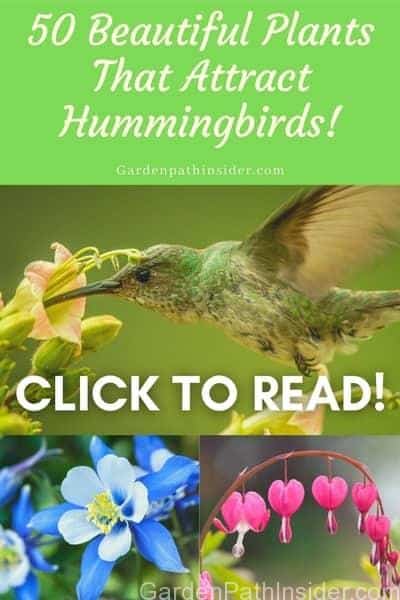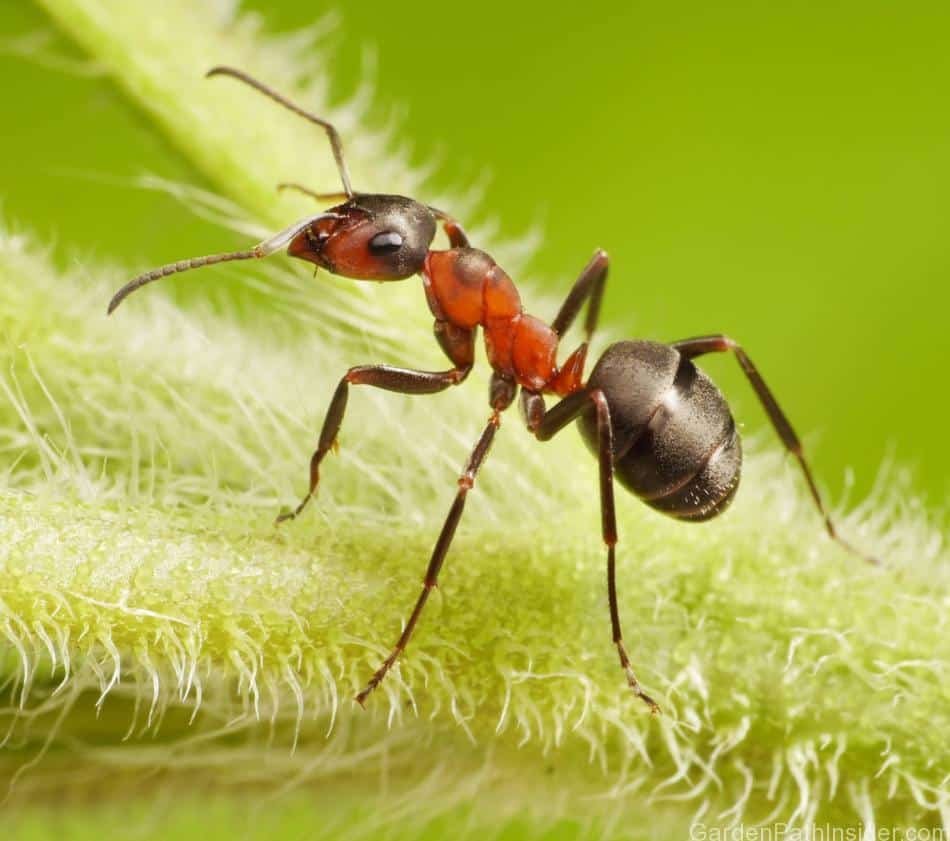
Ants have very structured societies with different classes from queens to workers and protectors. Within ant society are protocols for farming and collecting food. Certain species of ants live in more remote areas that may lack the needed food source to sustain the entire ant nest. In these cases, the ants have developed many interesting practices to feed their colonies.
Ants can farm both crops and livestock. Leafcutter ants cut and collect leaves, and grow fungus on the leaves. The ants manage fungus crops that sustain the ant nest. Some species of ants herd and protect aphids for the purpose of collecting the aphids’ sugary excrement called honeydew.
Ants use interesting processes to develop and maintain their fungus crops. However, the way ants farm honeydew from their aphid herds is even more interesting.
Continue on to read about Fungus-farming ants, and how ants herd and milk aphids.
Many species of ants find unique ways to collect food and feed their nestmates.
Before we continue it is important to note that “ants that farm” are different from “Ant Farms”. Ant farms (also known as formicarium) are the containers that humans keep and maintain ants in. The practice of keeping ants is a wonderful way to study and enjoy the interesting culture of an ant colony.
Read more about ant farms in our article: “Are Ant Farms Cruel”, where we cover the benefits of keeping ants in healthy and humane ant farms.
If you would like to see what ant farms look like click here to go to our product recommendation page where we talk through the different types and sizes of ant farms that are currently trending in the ant farm (formicarium) community.
Cover image: Red wood ant_formica on green grass_© antrey
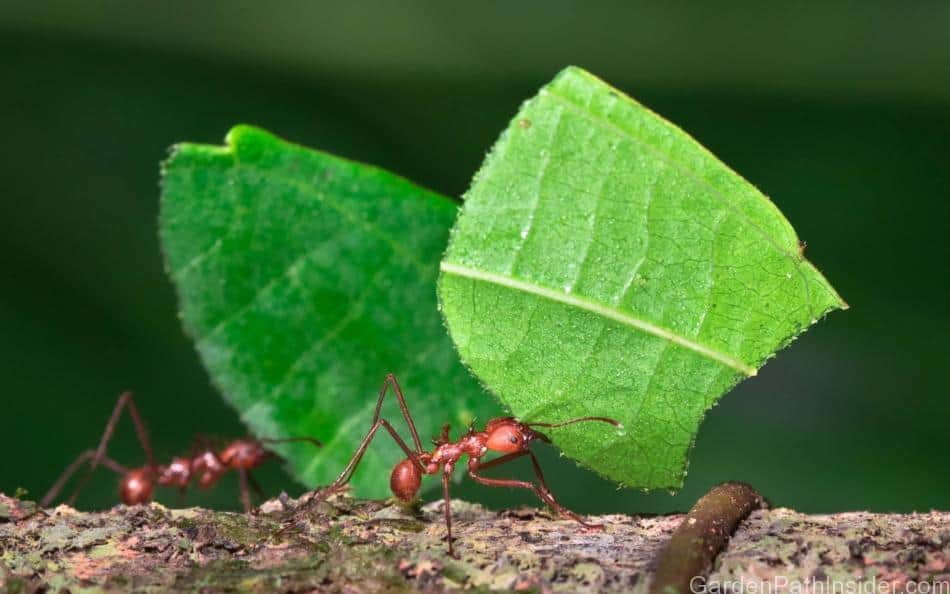
Fungus-Growing Ants
There are over 200 species of ants that solely depend on their farming skills to provide food for their colony. Over millions of years of mutualism, ants and fungus have worked to keep each other alive.
Attini ants are a family of fungus-growing ants that grow and maintain large gardens of fungus. The fungus is grown on organic matter like leaves and grass clippings and used to feed the larva and adult ants in a colony. Leaf cutter ants are one of the most well-known Attini ant species.
The mutualistic bond between ants and fungus goes back millions of years, and today the ants and fungus are both dependent on each other for survival. With such a long history of working together, the ants have developed many interesting ways to farm fungus in even the harshest conditions.
There are over 200 species of fungus cultivating ants, also referred to as Attini ants. Some ants like the leafcutter ants will harvest select foliage for their garden. The leafcutter ants, as the name suggests, will cut leaves from trees or even blades of grass and carry the clippings back to their nest.
Once at the nest the ants will arrange the leaves in sheltered locations in their gardens, and introduce fungus onto the freshly cut leaves. This is similar to humans planting flowers in a garden bed.
Fungus growing ants are believed to have developed very close with the species of fungus they cultivate, as many species of Attini ants will only grow specific types of fungus.
The fungus-growing ants are so adept at growing and harvesting fungus, the ants can even grow it underground in their nests. Some nests can grow to 0.002 m3 in volume and extend to depths of 7 meters. These nests can contain many cavities of fungus gardens, grown on plant matter, frass (poop), and other organic matter. Source: fs.usda.gov
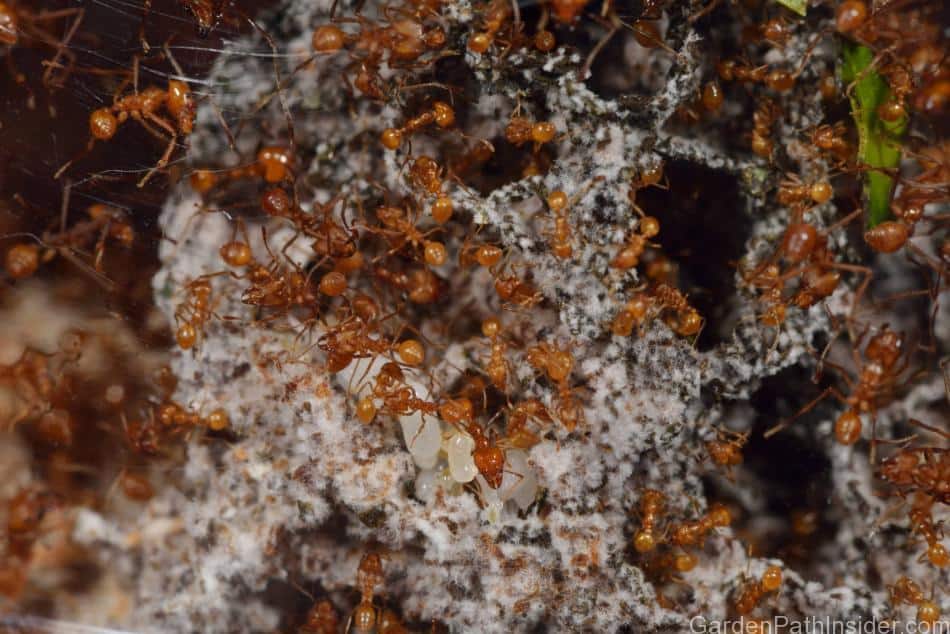
In the image above we see the leafcutter ants hard at work in their fungus garden. In the center of the image, we see ants tending to the larva that is sheltered and raised in the center of this fungus garden. In the top right corner of the image, we see ants installing a new leaf segment into their garden. Although this looks like a chaotic scene, the ants are very careful in maintaining the fungus, and if any disease appears in their fungus garden, the ants move quickly to quarantine and remove the diseased segments of the garden.
The fungus in an ant colony is so important when a queen ant leaves the nest to form a new colony, the queen will often take a fungus pellet with her to begin the next colony’s fungus garden.
To learn more about ants, click the link below to read our article on ants and the impact they have on gardens.
Click the link to read Do Ants Poop? An Insect Poop Guide.
Successful Attini ant colonies can have well over one million ants in the colony, with gardens so large they completely transform the ecosystem around the ant nest.
Ant fungus mutualism is not just seen in ants farming fungus, it is also seen in ants herding livestock.
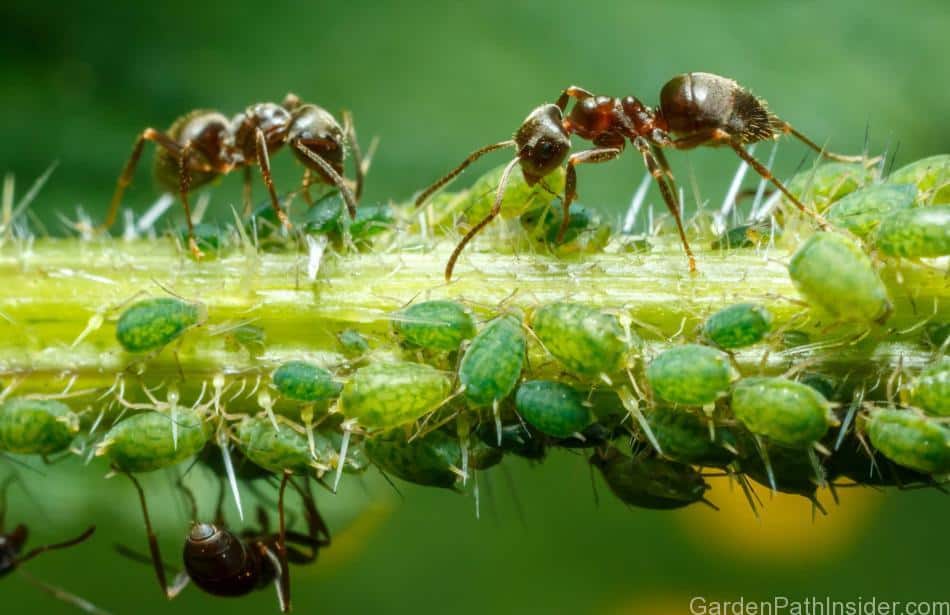
Do Ants Eat Aphids?
Ants are an extremely resourceful species that have found many ways to adapt and thrive in harsh environments. One tactic ants use to survive is to form mutualistic relationships with other insects, in a partnership to benefit both ants and aphids.
Ants do not eat aphids. Ants herd and protect aphids to harvest the sugary liquid that aphids produce and excrete called honeydew. Honeydew is a clear liquid and by-product of aphids, due to their diet of plant sap. Ants use their antenna to milk the honeydew out of aphids.
Some species of ants are more involved in the protection and raising of their aphid livestock. The ants will bring aphid eggs into the ant nest to winter. Then in spring, the ants bring the newly hatched aphids back out to begin feeding on plants and producing honeydew. Some ants have even been known to bite the wings off the aphids to prevent the aphids from flying away.
In the image above, we see ants maintaining their aphid herd. The ants are herding the aphids, as well as milking the honeydew from the aphids’ rear end.
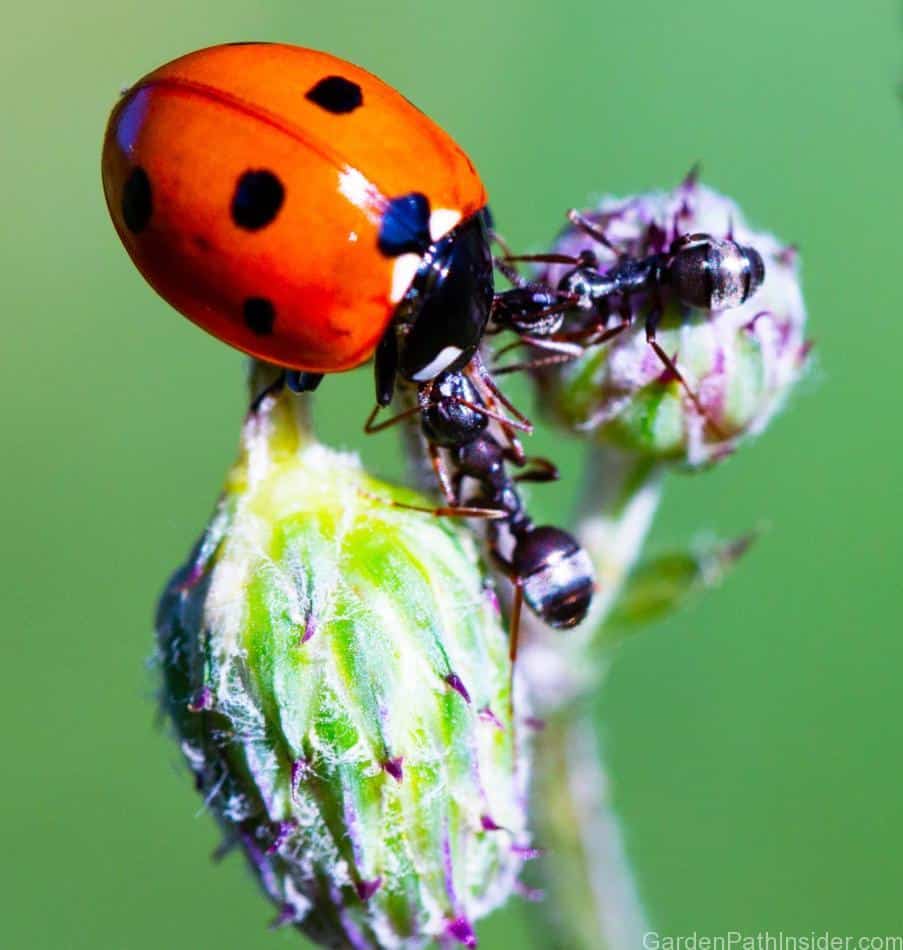
In the image above we see two ants fighting off a ladybug who is trying to eat the ants’ aphid herd.
Other species of ants like the European Lasius flavus, yellow meadow ant, will bring aphids down into their ant nest so the aphids can feed on the roots of the plants. This allows the ants to more easily herd and control the aphids underground in their nest.
To learn more about ants, click the link below to read our article on ants and the impact they have on gardens.
Click the link to read Do Ants Poop? An Insect Poop Guide.
How to Stop Ants Farming Aphids?
While some species of ants, like leaf cutter ants, can cut apart and destroy plants quickly; ants as a species do not tend to harm farm crops while they are growing. Aphids on the other hand are pests in almost every garden they are found. The mutually beneficial relationship ants and aphids share becomes a problem when ants are herding and farming aphids in our fruit and vegetable gardens.
To stop ants from farming aphids in your garden, you must remove the aphids. Ants herd aphids to drink the aphids’ sugary honeydew excrement. Aphids produce honeydew by drinking sap. Aphids are the real threat to plants. Introduce ladybugs to eat the aphids, or a pesticide to eliminate the ants.
The aphids are the real threat to the well-being of a garden, rarely are the ants destroying crops. Fortunately, there are many natural methods you can try before the need to introduce pesticides to your garden.
To stop ants from farming aphids in your garden, you can deploy ant traps, or sprays to kill the ants. Or you can use natural deterrents, like vinegar, coffee grounds, or citrus peels. These smells tend to interrupt the scent trails laid down by the ants.
Additionally, you can introduce ladybugs to your garden to eat the aphids. This may be less effective to stop ants from farming aphids in your garden, as the ants actively protect the aphids from predators. For the ladybug strategy to work, you would need a significant quantity of ladybugs.
The USDA notes that aphids are often effectively controlled by nature. Citing adverse weather conditions such as beating rains and low temperatures to reduce the aphid population. Source: fs.usda.gov
If you choose to use ladybugs as a natural pest control method, you can buy them in bulk at most home stores, or online. See our ladybug buying guide recommendations here.
A word of caution with buying and handling ladybugs: the ladybug has been known to infest homes and garden sheds in the colder months of the season.
If you are experiencing an infestation of ants or ladybugs, the first step is to contact a local pest control professional to discuss the options to exterminate the infestation.
A professional will be able to address the current infestation and then apply a barrier to prevent future infestations. There are also options you can buy at your local home store, though it may be beneficial to still consult with a professional before tackling the nest on your own.
To learn more about ladybugs, click the link below to read our article on Ladybugs and the impact they have on gardens.
Click the link to read Do Ladybugs Poop? An Insect Poop Guide.
Do Ants Farm Woodlice?
Ants do not farm all insects they live around. Some insects engage in mutualistic behaviors that will benefit the ants and the visitor insects.
Ants do not eat woodlice, woodlice are primarily the prey of spiders. However, woodlice and ants do engage in mutualistic behaviors. Woodlice feed on ant poop, and ants benefit by having their poop removed from their nest. This helps maintain a hygienic environment for the ants’ larva.
Woodlice have many names based on the location and culture they are found. Around our home, we have referred to woodlice as roly-poly or pill bugs, as the woodlice will ball up when presented with a threat. If woodlice are found in the home, they can be easily swept up in a dust bin and released outside in the garden.
To learn more about ants, click the link below to read our article on ants and the impact they have on gardens.
Click the link to read Do Ants Poop? An Insect Poop Guide.
Next Read, Butterfly Garden!
Click the image below to read our article on 50 Beautiful Plants and Flowers to Attract Butterflies to Your Yard!
In this article, we provide beautiful images and fun ideas for gardens of any size. From window sill gardens to large backyard landscapes. Find the perfect flowers for your next Butterfly Garden! Click below to read!
Next Read, Hummingbird Garden!
Click the image below to read our article on 50 Beautiful Plants That Attract Hummingbirds to Your Yard!
In this article, we provide images of beautiful flowers to attract and support hummingbirds. There are plants for nearly every growing condition and garden size. Click the image below to learn fun new flowers that will bring these beautiful birds to your yard!
The sources below were used for additional research and clarification for this article:
Google.com
Wikipedia.com


